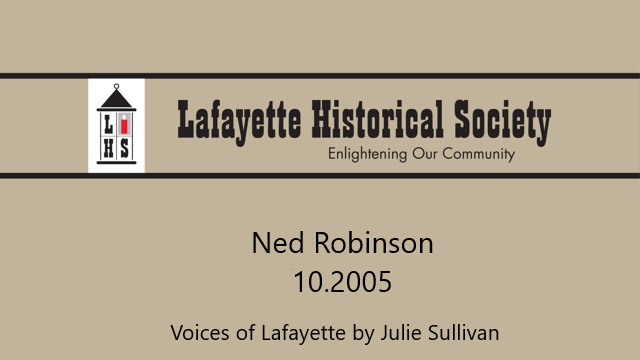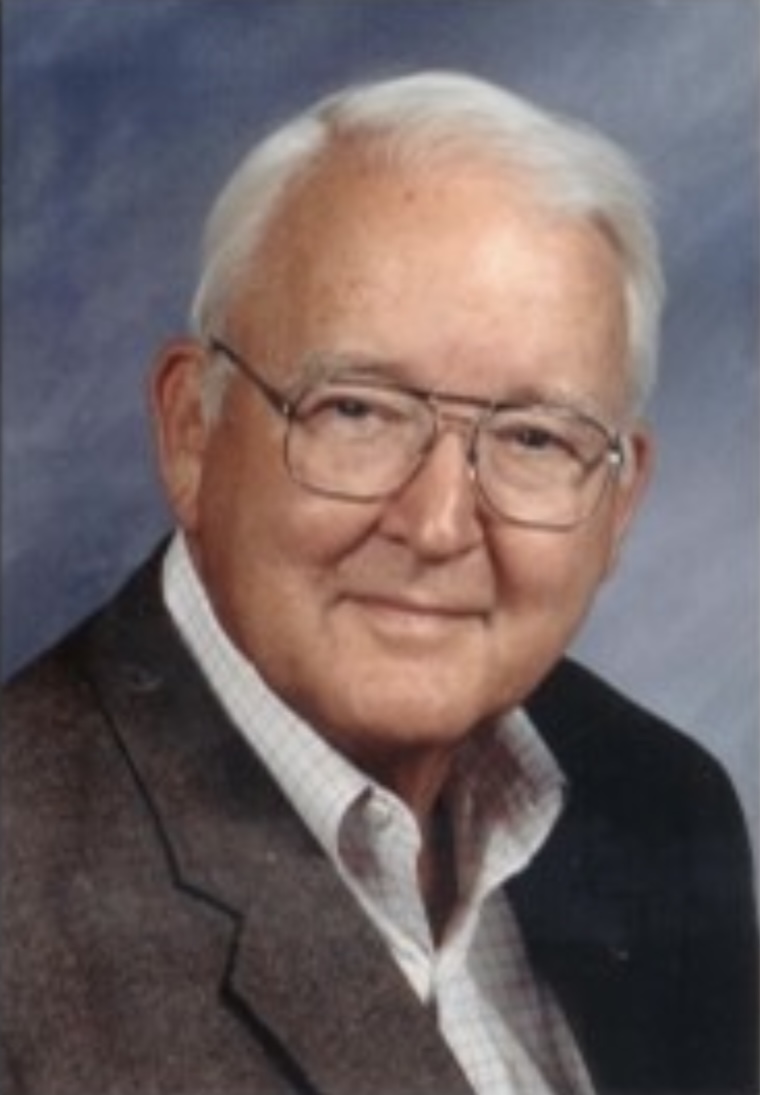Summary:
Ned Robinson was interviewed by Julie Sullivan in October, 2005. He was the Fourth mayor of the City of Lafayette and served on the City Council for many years. His proposal for a city government that was limited to “the three P’s: good planning, police protection, and public works,” and therefore would not require adding to the current level of property taxes, contributed to a successful campaign for incorporation on the second attempt. His experience as a lawyer who worked with property owners and developers proved valuable as he and his colleagues created the first general plan for the City and a master plan for the central town.
Oral History:
“In 1968, incorporation totally turned Lafayette around,” according to Ned Robinson, the city’s fourth mayor. “In the incorporation election prior to 1968, I was the principal spokesman for the committee against incorporation. We did not want or need a full-service city or the taxes that went with it. We didn’t need extensive parks because we had large yards, and the reservoir and regional parks were nearby. We wanted what I call the three P’s: good planning, police protection and public works, meaning roads.”
After Lafayette’s first attempt at incorporating failed, Bill Chilcote, who headed the Lafayette Improvement Association, and Donn Black, head of the Lafayette Design Project (later the city’s first mayor), asked Ned to join a committee to study incorporation further. “Bill Zion, Lafayette resident and economic consultant, did a report showing the city could incorporate without imposing a property tax as long as they went with the three P’s,” Ned explains. “After the freeway was built, PG&E was under grounding the utilities, and we learned we would have more influence on where this happened if Lafayette was a city.” The second effort was successful.
Ned, a partner in the Oakland law firm of Breed, Robinson and Stewart, specialized primarily in real estate law in Alameda and Contra Costa Counties. “I represented a lot of developers,” he says. “Prior to incorporation, when I took a project to the county planning commission in Martinez, I was never turned down, and only occasionally had to modify something. They would approve anything, and lots of apartment houses were in the plans for Lafayette.”
After incorporation, Ned was a member of the 49ers, a forty-nine citizen committee that came up with the city’s first general plan. “The plan called Lafayette a ‘semi-rural’ community,” he says. “We wanted to keep it mostly single family, and we did not want multiple dwelling units on the north side of the freeway or the west end of town. The main thing we wanted in Lafayette was good planning.”
Ned ran for the original city council, finishing sixth out of twenty in the race for five seats. “I campaigned on no development on major ridge lines and careful development on major hillsides,” Ned explains. “Before incorporation, there were a few boxy houses being built on Lafayette Ridge. I thought it hurt the natural look.” Two years later in 1970, he ran again and was elected with the highest number of votes. He served three consecutive four-year terms, including 1971-72 as the city’s fourth mayor, and again in the late 70’s. He served on the council again from 1984-86, when a member resigned.
During Ned’s first term as mayor the council adopted the master plan for the central town, and while he was on the council, the first general plan for the entire town was also approved. “It was controversial,” he remembers, “because developers did not want to be told what to do. It defined areas where multiple dwellings could not go in.” During his last term on council, the Lafayette Park Hotel was approved. “It was also controversial because it was considered too big. It added a lot to the community.”
Ned, who was born and raised in Oakland, graduated from UC Berkeley and received his law degree at Boalt Hall School of Law. He completed officer training while at UC and was called up in 1952-54 during the Korean War, serving on a troop transport to Japan. He and his wife, Mardy, also a Cal grad, were married in 1951. Ned’s aunt lived in Happy Valley, and in 1953 while visiting her, Ned and Mardy found a vacant lot and decided to build here. “The original owners of our lot were the Ravazza brothers from Italy,” he remembers. “I negotiated with them between trips to Japan while I was still in the Navy.” The family moved to Lafayette in 1957. After their four children were grown, Mardy earned a securities license and resumed her career. The couple has eight grandchildren.
Ned joined Breed, Robinson and Stewart, where his great-uncle was the senior partner, in 1951 and moved his practice to Lafayette in 1987, where he retired in 2002. Ned’s grandfather, Arthur H. Breed, Sr., a state senator, was the property manager of the Moraga Ranch, which was owned by James Irvine. Ned remembers accompanying his grandfather to the ranch before World War II. “I idolized James Irvine. He also owned the Irvine Ranch for which the city of Irvine, California, was named,” Ned says. Ned was thrilled when “the great James Irvine” invited them to lunch. “He told the waiter to bring one check. He took it, did some figuring then told each of us what we owed. He said he didn’t get separate checks, because they rounded up the sales tax. By getting one check he had saved one or two cents. I’ve never forgotten that,” Ned says with a grin.
Years later, Ned’s law firm handled the sale of Moraga Ranch to Utah Construction Company, and later helped create the master plan for what would become the city of Moraga. “We were one of the principal firms that developed Moraga,” he says. “I remember Russ Bruzzone as a good developer and his wife, Joan, as an excellent businesswoman and negotiator. I went to college with Russ at Cal before he moved to Stanford.
“I remember Bill’s Drugs,” he adds. “My firm represented Blanche Pope Neal, who owned the old Army Navy store that Bill Eames rented and eventually bought for Bill’s Drugs. When we came to town the strip, that’s what it was known as, was already here. A lot of new houses were going up. There were more service stations in town then. Our home was under construction north of the old Standard Oil station next to Chaps Drive-In, our favorite lunch spot (near the intersection of Mt. Diablo and Happy Valley Rd.). Diablo Foods was a Louis store. The park in front of the Plaza was much smaller. Jack Kitchen was a businessman in Lafayette, and there was nothing but his home where Safeway and Albertson’s (now closed) are today. Petar’s was popular back then, because he always had attractive, buxom blonde hostesses, and the food was good.
“Marion Steinbeck, who lived in Lafayette, had a collection of Indian baskets that was donated to the Gatekeeper’s Museum in Tahoe City, where it occupies a special room and is very popular.
“Lafayette’s downtown is better-looking since the signs and wires came down as a result of incorporation. It’s more user friendly,” Ned says. “Hopefully, Lafayette won’t develop much more. Residential suburbs will be caught in the squeeze with the desire to set the limit line and protect farm land. Building town centers around BART stations will change the character of the area, but I don’t think apartments north of Lafayette BART are appropriate. I know Lafayette can remain a no property tax city if it so desires, and I hope it will.”
Excerpted from “Voices of Lafayette” by Julie Sullivan. This book is available for purchase in the History Room.



Leave a Reply